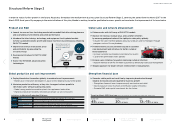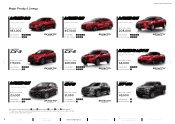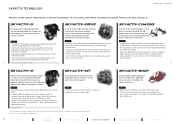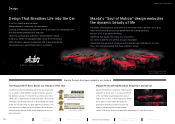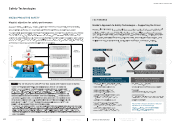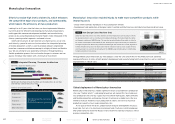Mazda 2016 Annual Report Download - page 20
Download and view the complete annual report
Please find page 20 of the 2016 Mazda annual report below. You can navigate through the pages in the report by either clicking on the pages listed below, or by using the keyword search tool below to find specific information within the annual report.
SKYACTIV-G 2.5T G-Vectoring Control
Mazda has enhanced its SKYACTIV-G
engine series with the newly developed
top-tier SKYACTIV-G 2.5T. This 2.5-liter
direct-injection turbocharged gasoline
engine powers the all-new CX-9 midsize
three-row crossover SUV, which was
launched starting in North America in
May 2016. In addition to being developed
through improvements to the naturally
aspirated SKYACTIV-G 2.5, which is
featured in the Mazda6, SKYACTIV-G 2.5T
delivers exceptional catalog and real-
world fuel economy. Moreover, the engine
realizes excellent response without turbo
lag*1 as well as linear and powerful accel-
eration in the low-to-mid-rpm range, in
which CX-9 drivers spend over 90% of
their driving time.*2 SKYACTIV-G 2.5T’s
maximum torque is 310 ft-lb, which is
on par with a naturally aspirated 4-liter
gasoline engine.
*1 A delay in acceleration response common in turbocharged
engines due to the time required for the compressor to
take effect.
*2 As of November 2015. Based on Mazda’s in-house
investigation.
Mazda has developed G-Vectoring Con-
trol (GVC), the first round of technology
for SKYACTIV-VEHICLE DYNAMICS, a
series of new-generation vehicle motion
control technologies. The Company plans
to gradually introduce GVC in all new-
generation models, starting with the
updated Mazda3, which went on sale in
Japan in July 2016.
GVC was developed based on Mazda’s
human-centered development philosophy
and the novel idea of using the engine to
enhance chassis performance. GVC
represents a form of control technology
that provides integrated control of lateral
and longitudinal acceleration forces,
which have until now been controlled
separately, by altering engine torque in
accordance with the driver’s steering. In
this way, GVC optimizes the vertical load
on each wheel, thereby realizing smooth
and efficient vehicle motion.*3
*3 As of June 2016 (production models, based on Mazda’s
research)
SKYACTIV TECHNOLOGY
Building-Block Strategy
As a result of having made dramatic improvements to the base technologies for a car’s
basic performance—including to the engine, transmission, body, and chassis—we are
pursuing a Building-Block Strategy of gradually adding electric devices, such as regenera-
tive braking and hybrid systems. Our approach is to effectively reduce CO2 emissions by
providing all customers with driving pleasure and outstanding environmental and safety
performance, rather than to rely heavily on a subset of environmentally friendly vehicles.
Mazda’s revolutionary base technology, SKYACTIV TECHNOLOGY, is improving the car’s
powertrain efficiency, such as the basic performance of the engine and transmission, and
bringing about profound improvements in such areas as vehicle weight reduction and
aerodynamics. Based on a Building-Block Strategy, base technologies and electric device
technologies are combined in the following three steps.
Internal
combustion
engines
Base engines
(internal
combustion engines)
Electric devices
Internal
combustion
engines
Base engines
(internal
combustion engines)
Electric devices
Internal
combustion
engines
Base engines
(internal
combustion engines)
Hybrids
Idling stop systems
Hybrids / Plug-in hybrids
Regenerative braking
Hybrids /
Plug-in hybrids
Regenerative
braking
Idling stop
systems
Idling stop systems
Anticipated Expansion in Adoption of Environmental Technologies (Through 2020)
Graphic representation of global market share of powertrain technologies
2009 20202015
EVs
EVs
• Introduction of hybrid technology
and idling stop technology
• Expanded use of electric device
technologies and increased
introduction of electric vehicles (EVs)
• Stricter fuel economy standards globally
• Need for big boost in energy efficiency
• Expanded adoption of electric device
technologies
Base Technologies Powertrains, Reduced Body Weight, etc.
Battery Management Technology Idling Stop System “i-stop”
Regenerative Braking Regenerative Braking System “i-ELOOP”
Electric Drive Technology Hybrid System “SKYACTIV-HYBRID” / EVs
Building-Block Strategy
step 1
step 2
step 3
MAZDA ANNUAL REPORT 2016
18 Drivers of Value Creation
Message from
Management
Review of Operations
Foundations Underpinning
Sustainable Growth
Financial Section
Contents


